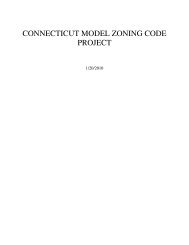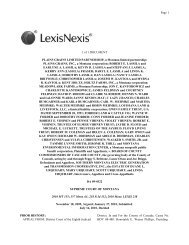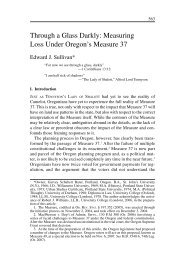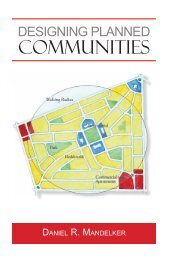LEXSEE DANIEL GUGGENHEIM; SUSAN ... - Land Use Law
LEXSEE DANIEL GUGGENHEIM; SUSAN ... - Land Use Law
LEXSEE DANIEL GUGGENHEIM; SUSAN ... - Land Use Law
Create successful ePaper yourself
Turn your PDF publications into a flip-book with our unique Google optimized e-Paper software.
2010 U.S. App. LEXIS 25981, *16Page 6may be available. But under Suitum this ripenessrequirement now appears to be prudential rather thanjurisdictional.27 371 F.3d 1046, 1052-54 (9th Cir. 2004).28 96 F.3d 401, 406-07 (9th Cir. 1996).29 447 U.S. 255, 260, 100 S. Ct. 2138, 65 L. Ed.2d 106 (1980).30 Lingle v. Chevron U.S.A. Inc., 544 U.S. 528,545, 125 S. Ct. 2074, 161 L. Ed. 2d 876 (2005).In this case, we assume without deciding that theclaim is ripe, and exercise our discretion not to imposethe prudential requirement of exhaustion in state court.Two factors persuade us to follow this course. First, wereject the Guggenheims' claim on the merits, so it wouldbe a waste of the parties' and the courts' resources tobounce the case through more rounds of litigation.Second, the Guggenheims did indeed litigate in statecourt, and they and the City of Goleta settled in statecourt. Unfortunately the law changed after their trip tostate court, so they might well have proceeded differentlythere had they been there after Lingle came down, but itis hard to see any value in forcing a second trip on them.B. Penn Central and PalazzoloThe [*17] Guggenheims challenge only the 2002City of Goleta ordinance, not the 1979 or 1987 County ofSanta Barbara ordinances. The fundamental weakness ofthe dissent is its blending of the economic effects of allthree ordinances, even though challenges to the first twohave long been barred and are not asserted. There is a bigproblem with challenging as a taking the government'sfailure to repeal a long existing law. The Countyordinances were both promulgated long before theGuggenheims bought their land, and the rent controlregime created by the county ordinances limited the valueof the land when the Guggenheims bought it. TheGuggenheims assert no claim against the County of SantaBarbara, just the City of Goleta. They frame theirchallenge narrowly, solely as a facial challenge to theCity of Goleta ordinance promulgated in 2002. And theyargue that their facial challenge should be evaluatedunder Penn Central Transportation Co. v. New York City.31 We assume, without deciding, that a facial challengecan be made under Penn Central. 3231 438 U.S. 104, 98 S. Ct. 2646, 57 L. Ed. 2d631 (1977).32 See Tahoe-Sierra Preserv. Council, Inc. v.Tahoe Reg. Planning Agency, 535 U.S. 302, 334,122 S. Ct. 1465, 152 L. Ed. 2d 517 (2002) ("[I]fpetitioners had challenged [*18] the applicationof the moratoria to their individual parcels,instead of making a facial challenge, some ofthem might have prevailed under a Penn Centralanalysis.").Palazzolo v. Rhode Island 33 is of no help to theGuggenheims. They do not have the problem thatPalazzolo solved. In Palazzolo the taking was from thefirst owner and the "as applied" lawsuit was by thesecond. The transfer was by operation of law, during theperiod when the owner was ripening the claim byexhausting state remedies. 34 One reason why thesedistinctions matter is that even though in Palazzolo titlepassed to the plaintiff after the land use restriction wasenacted, he acquired his economic interest as a 100%shareholder in the corporation owning the land before theland use restriction was enacted, and title shifted to himbecause his corporation was dissolved, not because hebought the property for a low price reflecting theeconomic effect of the regulation.33 533 U.S. 606, 627-28, 121 S. Ct. 2448, 150 L.Ed. 2d 592 (2001).34 Id. at 614.Palazzolo holds that an owner who acquires title toproperty during the period required for an as appliedregulatory taking to ripen (in that case during proceedingson applications to build on wetlands) [*19] is notnecessarily barred from bringing the action when it ripenseven though he did not own the property when theregulation first started to be applied to the property. 35This difference matters because an as applied challengenecessarily addresses the period during which theadministrative or judicial proceedings for relief occur, sojustice may require that title transfers during the ripeningperiod not bar the action. By contrast, there is no suchextended period applicable to a facial challenge, becausethe only time that matters is the time the ordinance wasadopted.35 Id. at 628 ("A challenge to a land useregulation, by contrast, does not mature untilripeness requirements have been satisfied, underprinciples we have discussed; until this point aninverse condemnation claim alleging a regulatorytaking cannot be maintained. It would be illogical,and unfair, to bar a regulatory takings claim







